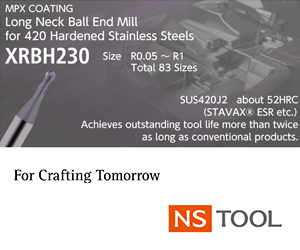
Courtesy of United Grinding
The Studer S40 CNC cylindrical grinder from United Grinding enables Damen Carbide to process shafts up to 63" long and weighing 286 lbs.
Technology change has a universal impact on parts manufacturers—from the largest plant to the smallest shop. Most of the manufacturers who have taken the leap and invested in new technology have found they’ve made the right decision because of the productivity gains they’ve realized. What some might not have foreseen, however, is that once they’ve made the leap forward, they have to continue that process if they expect to keep up with changing technology.
Damen Carbide Tool Co. Inc. is one manufacturer that understands it has to keep leaping. “You have to keep up with the technology or the doors will be closed,” said John Bachmeier, company president. He added that the company has always done that.
The Wood Dale, Ill., job shop dates to 1948 and produces wear parts, dies, saws, knives, slitters, special tools and other components made of tool and alloy steels, carbide, ceramics, titanium and exotics via milling, turning, EDMing, and jig, flat, ID, OD and profile grinding. “You name the industry, and somewhere on a vendor list you’ll find Damen Carbide,” Bachmeier said.
He noted that the shop has long been able to hold tolerances of ±0.0001" and tighter and impart surface finishes as fine as 2µm to 3µm rms.
Nonetheless, the shop needed to replace its reliable battery of grinders and take its grinding capabilities to the “next level” to reduce cycle times and expand the types of parts it could produce while maintaining a high level of precision.
Bachmeier called Integrated Machinery Systems, an Itasca, Ill., distributor of machine tools and automation products that Damen Carbide had worked with in the past. Together, they looked at several grinding machine builders and compared features, programming, part loading/ unloading, processing capability and wheel and dressing monitors. Based on their research, they were drawn to the various grinder brands from United Grinding Technologies Inc., Miamisburg, Ohio.
Over time, Damen Carbide purchased five CNC Studers: three S40 cylindrical grinders, an S31 cylindrical grinder and an S22 production grinding platform. In addition, the shop bought a Blohm Profimat MT 408 for surface, profile and creep-feed grinding and a Walter tool and cutter grinder, with another Walter on order.
The new equipment enabled Damen Carbide to reduce cycle times, particularly ID and OD grinding on the Studer machines, and allowed one person to operate multiple machines.
In addition, the shop was able to bid on RFQs that it previously was unable to because of capacity limitations. For example, the S40, which provides up to four grinding wheels via a turret wheelhead that automatically swivels and has a high-resolution B-axis and C-axis for form and thread grinding, gives Damen Carbide the capability to grind longer and heavier workpieces—up to 63" and 286 lbs. Previously, the maximum length was about 25".
“The CNC S40s have opened new doors to customers in the long-shaft business,” Bachmeier said, noting that it’s possible to grind a small part in a big machine but not vice versa. “We make parts only 1" long in those machines.”
Also, the S22’s HSG (high-speed grinding) package, which offers circumferential speeds up to 140 m/sec., enables out-of-round grinding of any shape, such as hexagon, triangle or square. “It calculates so fast that I can put a round part in the machine and make a square out of it,” Bachmeier said.
Damen Carbide still uses some of the older grinders, even circa-1950 ones, to perform secondary operations and produce small part runs because it’s difficult to make a profit setting up those jobs on a CNC grinder, Bachmeier explained. “Once you have 10 or more pieces, then it’s worth using the CNC.”
Besides grinding speed, a major difference between older and new technology is the price of the machine. “Back in the day, you could buy a machine for $30,000, $40,000, $50,000,” Bachmeier said. “That’s not even a 10 percent down payment on one of these machines.”
While the financial risk for Damen Carbide has increased, so has the reward. “When we put on our Web site that we had five CNC Studers, it was amazing the number of new and large customers that called us,” Bachmeier said.
Related Glossary Terms
- alloy steels
alloy steels
Steel containing specified quantities of alloying elements (other than carbon and the commonly accepted amounts of manganese, sulfur and phosphorus) added to cause changes in the metal’s mechanical and/or physical properties. Principal alloying elements are nickel, chromium, molybdenum and silicon. Some grades of alloy steels contain one or more of these elements: vanadium, boron, lead and copper.
- ceramics
ceramics
Cutting tool materials based on aluminum oxide and silicon nitride. Ceramic tools can withstand higher cutting speeds than cemented carbide tools when machining hardened steels, cast irons and high-temperature alloys.
- computer numerical control ( CNC)
computer numerical control ( CNC)
Microprocessor-based controller dedicated to a machine tool that permits the creation or modification of parts. Programmed numerical control activates the machine’s servos and spindle drives and controls the various machining operations. See DNC, direct numerical control; NC, numerical control.
- creep-feed grinding
creep-feed grinding
Grinding operation in which the grinding wheel is slowly fed into the workpiece at sufficient depth of cut to accomplish in one pass what otherwise would require repeated passes. See grinding.
- dressing
dressing
Removal of undesirable materials from “loaded” grinding wheels using a single- or multi-point diamond or other tool. The process also exposes unused, sharp abrasive points. See loading; truing.
- flat ( screw flat)
flat ( screw flat)
Flat surface machined into the shank of a cutting tool for enhanced holding of the tool.
- gang cutting ( milling)
gang cutting ( milling)
Machining with several cutters mounted on a single arbor, generally for simultaneous cutting.
- grinding
grinding
Machining operation in which material is removed from the workpiece by a powered abrasive wheel, stone, belt, paste, sheet, compound, slurry, etc. Takes various forms: surface grinding (creates flat and/or squared surfaces); cylindrical grinding (for external cylindrical and tapered shapes, fillets, undercuts, etc.); centerless grinding; chamfering; thread and form grinding; tool and cutter grinding; offhand grinding; lapping and polishing (grinding with extremely fine grits to create ultrasmooth surfaces); honing; and disc grinding.
- grinding machine
grinding machine
Powers a grinding wheel or other abrasive tool for the purpose of removing metal and finishing workpieces to close tolerances. Provides smooth, square, parallel and accurate workpiece surfaces. When ultrasmooth surfaces and finishes on the order of microns are required, lapping and honing machines (precision grinders that run abrasives with extremely fine, uniform grits) are used. In its “finishing” role, the grinder is perhaps the most widely used machine tool. Various styles are available: bench and pedestal grinders for sharpening lathe bits and drills; surface grinders for producing square, parallel, smooth and accurate parts; cylindrical and centerless grinders; center-hole grinders; form grinders; facemill and endmill grinders; gear-cutting grinders; jig grinders; abrasive belt (backstand, swing-frame, belt-roll) grinders; tool and cutter grinders for sharpening and resharpening cutting tools; carbide grinders; hand-held die grinders; and abrasive cutoff saws.
- inner diameter ( ID)
inner diameter ( ID)
Dimension that defines the inside diameter of a cavity or hole. See OD, outer diameter.
- jig
jig
Tooling usually considered to be a stationary apparatus. A jig assists in the assembly or manufacture of a part or device. It holds the workpiece while guiding the cutting tool with a bushing. A jig used in subassembly or final assembly might provide assembly aids such as alignments and adjustments. See fixture.
- milling
milling
Machining operation in which metal or other material is removed by applying power to a rotating cutter. In vertical milling, the cutting tool is mounted vertically on the spindle. In horizontal milling, the cutting tool is mounted horizontally, either directly on the spindle or on an arbor. Horizontal milling is further broken down into conventional milling, where the cutter rotates opposite the direction of feed, or “up” into the workpiece; and climb milling, where the cutter rotates in the direction of feed, or “down” into the workpiece. Milling operations include plane or surface milling, endmilling, facemilling, angle milling, form milling and profiling.
- outer diameter ( OD)
outer diameter ( OD)
Dimension that defines the exterior diameter of a cylindrical or round part. See ID, inner diameter.
- turning
turning
Workpiece is held in a chuck, mounted on a face plate or secured between centers and rotated while a cutting tool, normally a single-point tool, is fed into it along its periphery or across its end or face. Takes the form of straight turning (cutting along the periphery of the workpiece); taper turning (creating a taper); step turning (turning different-size diameters on the same work); chamfering (beveling an edge or shoulder); facing (cutting on an end); turning threads (usually external but can be internal); roughing (high-volume metal removal); and finishing (final light cuts). Performed on lathes, turning centers, chucking machines, automatic screw machines and similar machines.
- web
web
On a rotating tool, the portion of the tool body that joins the lands. Web is thicker at the shank end, relative to the point end, providing maximum torsional strength.








